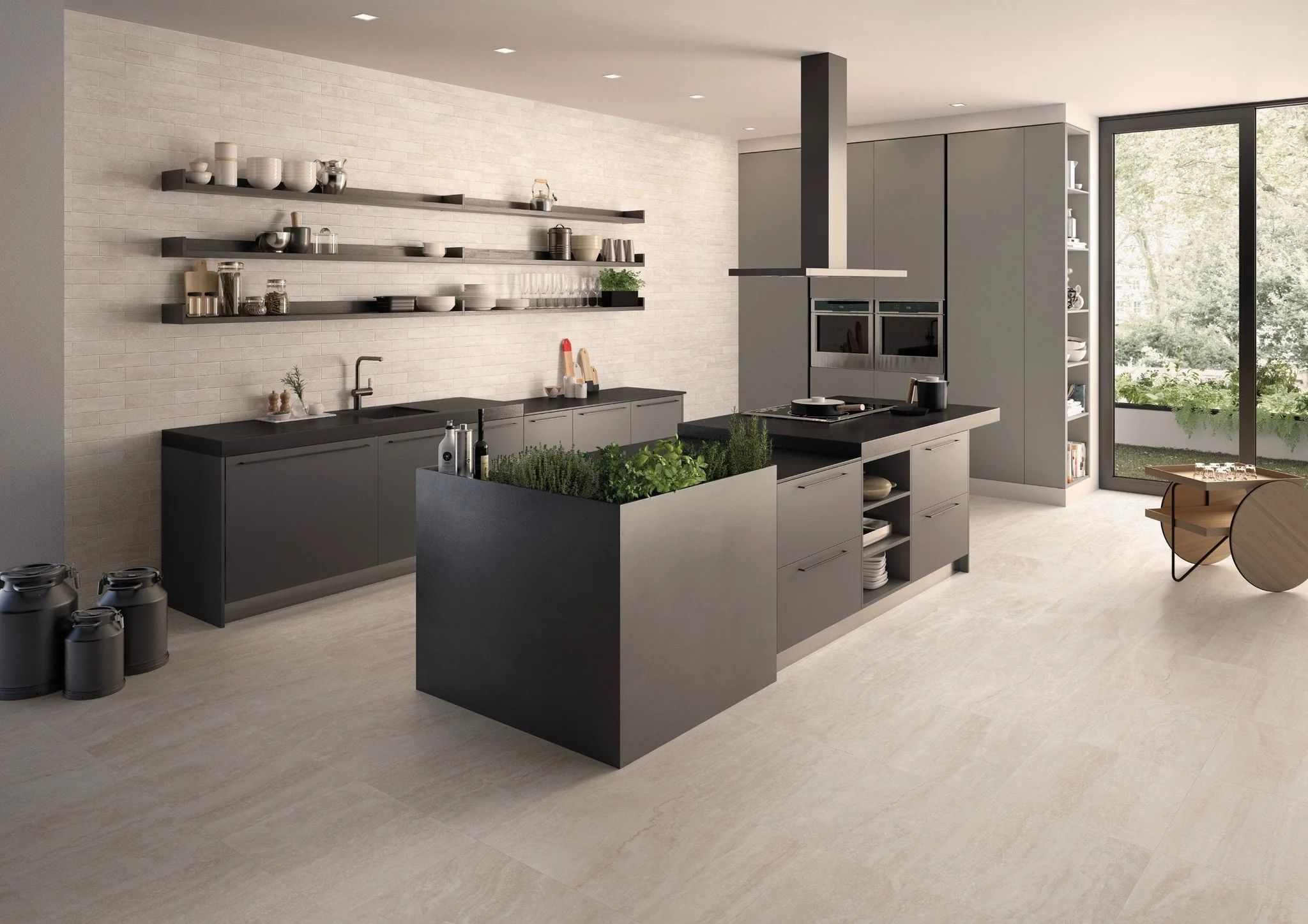The kitchen is the heart of the home, a space where meals are prepared, families gather, and memories are made. Given the high level of foot traffic and exposure to spills, moisture, and heat, selecting the right kitchen flooring option is essential. Whether you’re looking for kitchen floor tile ideas, the warmth of hardwood, or the affordability of vinyl kitchen flooring, this guide will help you make an informed decision. Below, we break down the best flooring for kitchen spaces, analyzing their pros, cons, and ideal applications
1. Ceramic and Porcelain Tiles – A Classic and Durable Choice
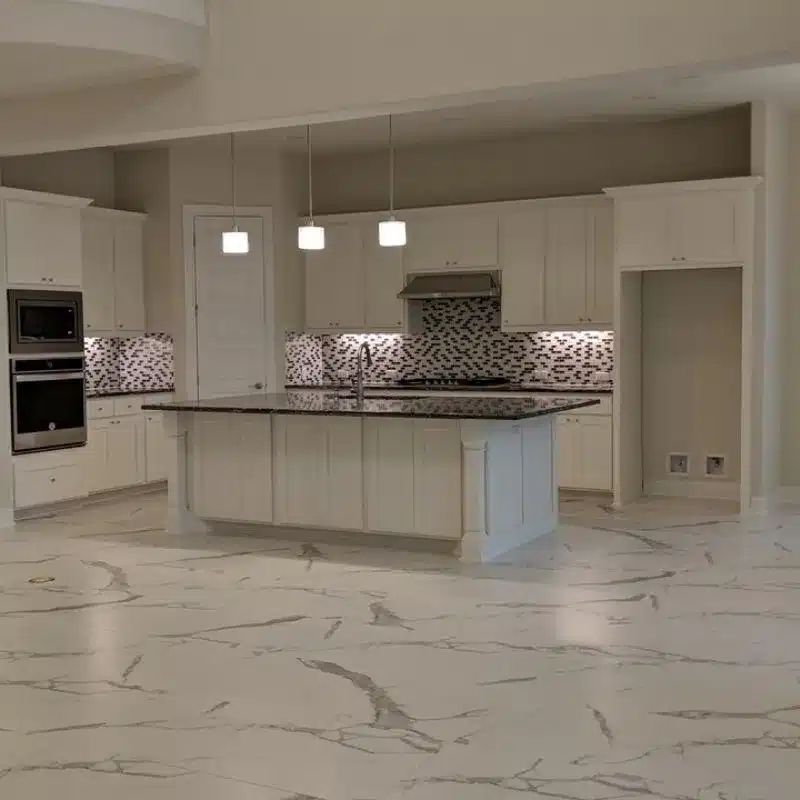
Ceramic and porcelain tiles are among the most widely used kitchen flooring ideas due to their remarkable durability and moisture resistance. These tiles come in a vast array of colors, textures, and finishes, offering homeowners the ability to create stunning, customized kitchen floors.
Pros:
- Moisture Resistant: Unlike wood and laminate, ceramic and porcelain tiles do not absorb water, making them an ideal choice for kitchen spaces prone to spills.
- Durability: These tiles can last decades with minimal maintenance, resisting scratches, stains, and heavy foot traffic.
- Easy to Clean: Requires only regular sweeping and mopping to keep them looking fresh.
- Variety of Designs: From sleek white tiles to stone-look or even wood-look kitchen floor tile options, there are endless aesthetic possibilities.
Cons:
- Hard Surface: Standing on ceramic or porcelain tiles for extended periods can cause discomfort, which is why kitchen floor mats may be necessary.
- Can Crack: Heavy objects, such as cast iron pans, can cause cracks or chips if dropped.
- Grout Maintenance: Over time, grout can become discolored and requires periodic sealing to maintain its appearance.
Best For:
- Homeowners looking for stylish, durable kitchen flooring options.
- Busy kitchens that require low maintenance and moisture-resistant floors.
2. Vinyl Kitchen Flooring – Affordable and Stylish
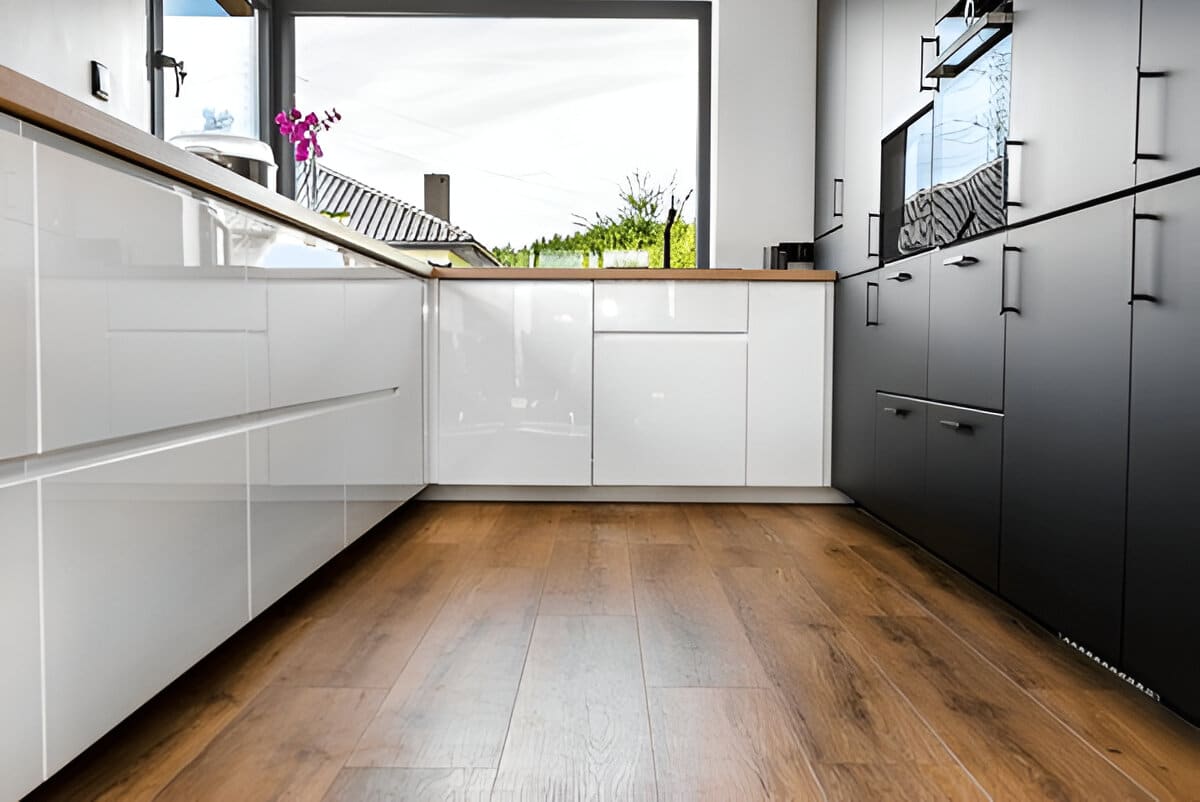
Vinyl flooring has come a long way in recent years, evolving into one of the best kitchen flooring options for homeowners seeking an affordable yet stylish solution. Available in sheets, planks, and tiles, luxury vinyl tile (LVT) and vinyl plank flooring have become increasingly popular.
Pros:
- Waterproof: Vinyl flooring offers superior moisture resistance, protecting against spills and splashes.
- Comfortable: Unlike tiles, vinyl flooring has a softer, more cushioned feel, making it easier on the feet.
- Affordable: A budget-friendly alternative to hardwood and stone.
- Easy Installation: Peel-and-stick, glue-down, and click-lock systems make it an excellent DIY flooring option.
Cons:
- Less Durable Than Tile: Although vinyl floors can last for many years, they may show signs of wear and tear over time, especially in high-traffic kitchens.
- Not as Eco-Friendly: Made from synthetic materials, vinyl is not the most sustainable flooring choice.
- Can Fade: Prolonged exposure to direct sunlight can lead to discoloration.
Best For:
- Homeowners looking for budget-friendly kitchen flooring ideas.
- Families needing moisture-resistant and low-maintenance floors.
3. Solid Hardwood – A Timeless and Elegant Option

Hardwood flooring brings warmth, character, and a timeless charm to kitchens. While not traditionally recommended for busy kitchen areas due to its susceptibility to moisture, modern finishes and proper maintenance can make solid hardwood a viable choice.
Pros:
- Classic Aesthetic: The rich grains and natural look of solid hardwood add elegance and increase home value.
- Can Be Refinished: Unlike vinyl or laminate, scratches and dents in hardwood can be sanded out multiple times, extending its lifespan.
- Durable: With proper care, solid hardwood floors can last for decades.
Cons:
- Susceptible to Water Damage: Even with protective sealants, excessive moisture can cause warping, swelling, or rotting.
- Expensive: Solid hardwood is one of the most costly flooring options.
- Requires Maintenance: Needs refinishing every few years to maintain its appearance.
Best For:
- Homeowners prioritizing natural materials and classic elegance.
- Kitchens with minimal exposure to water and humidity.
4. Engineered Hardwood – The Best of Both Worlds
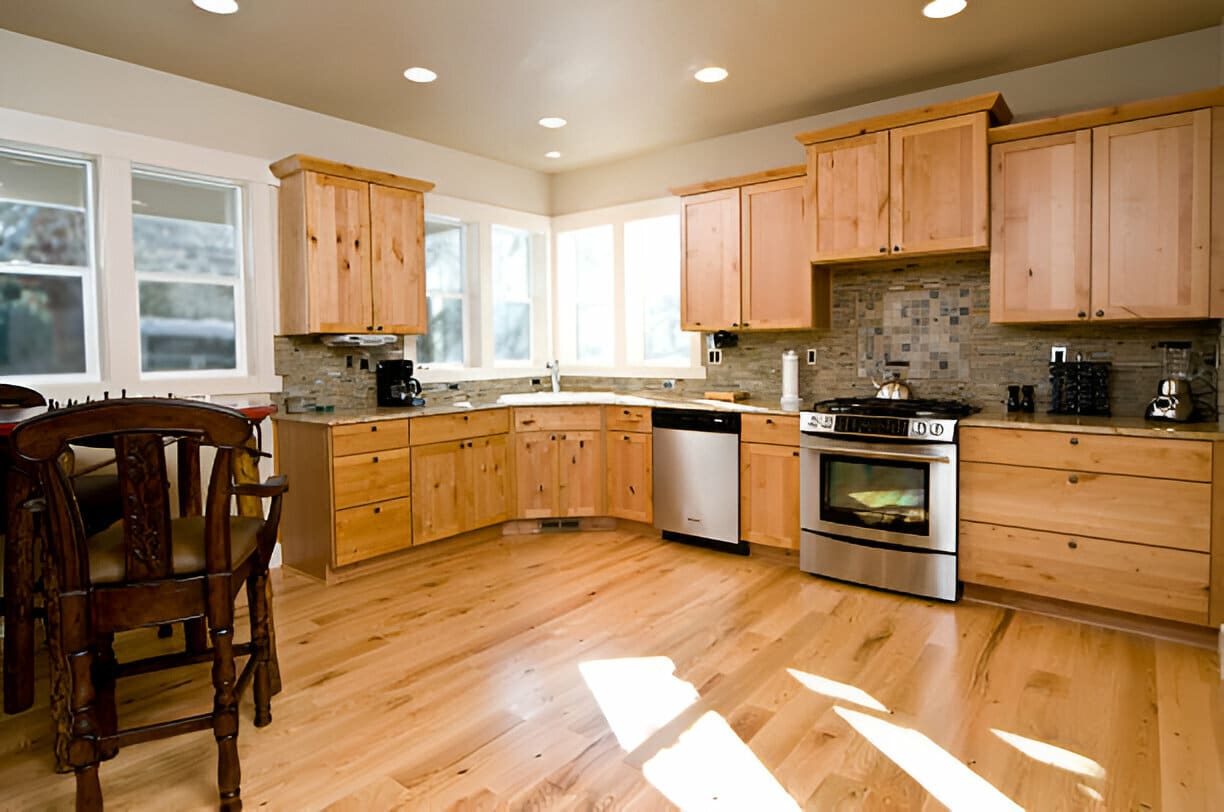
If you love the look of solid hardwood but need better resistance to moisture, engineered hardwood is an excellent alternative. Made with a real wood veneer atop a plywood core, it offers enhanced stability and resilience.
Pros:
- Better Water Resistance: More stable in humid conditions compared to solid hardwood.
- Stylish Look: Provides the same high-end aesthetic as real wood.
- Easy Installation: Available in click-lock systems, making it DIY-friendly.
Cons:
- Limited Refinishing: Unlike solid hardwood, engineered wood can only be sanded and refinished a couple of times.
- More Expensive Than Vinyl: While it’s cheaper than solid hardwood, it still costs more than laminate or vinyl.
Best For:
- Homeowners who want the beauty of wood with added moisture resistance.
- Open-concept homes where seamless flooring is preferred.
5. Laminate Flooring – A Cost-Effective Alternative
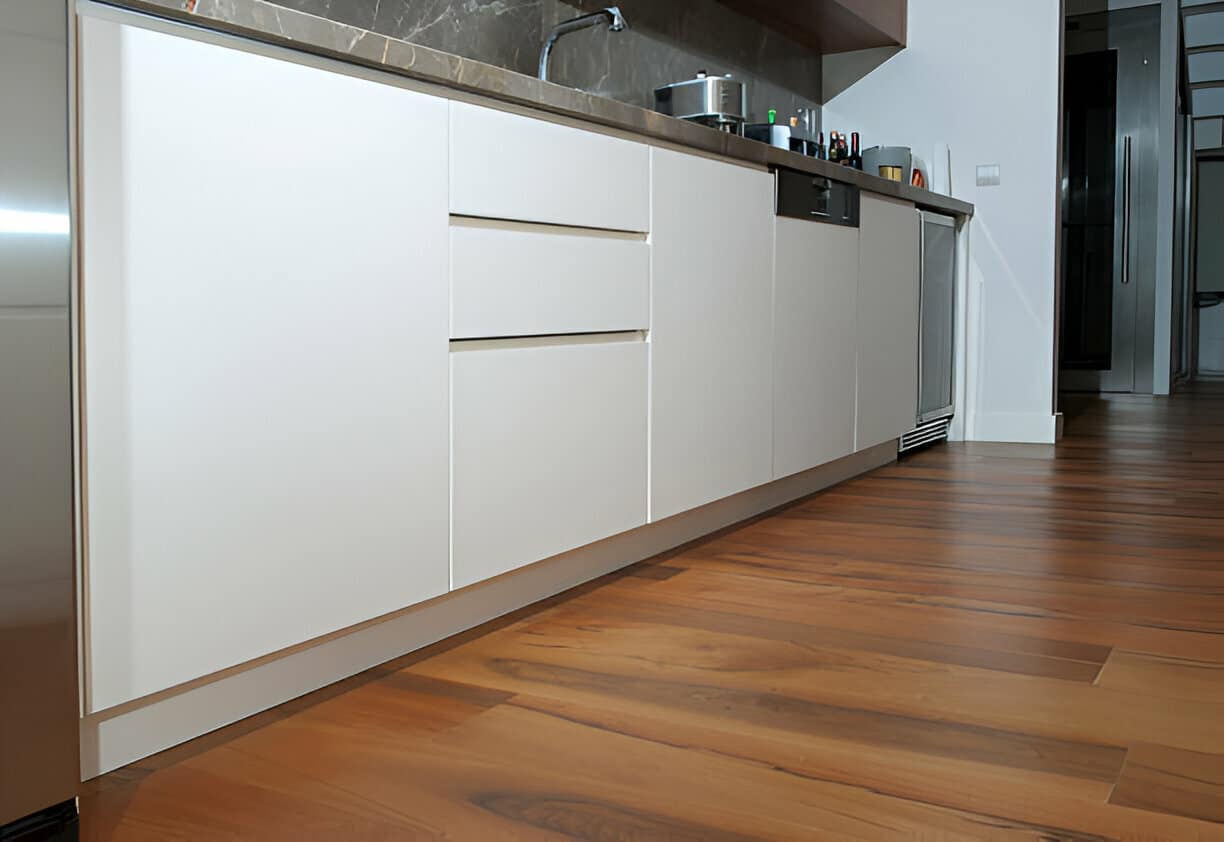
Laminate flooring offers the look of hardwood or stone at a fraction of the price. Made from composite wood with a photographic layer on top, it mimics the natural beauty of more expensive materials.
Pros:
- Affordable: One of the most budget-friendly flooring ideas.
- Easy to Clean: Resists stains and spills, making it a low-maintenance option.
- Scratch Resistant: More durable than hardwood, making it ideal for high-traffic kitchens.
Cons:
- Not Completely Waterproof: While some water-resistant laminate options exist, prolonged exposure to moisture can cause swelling and warping.
- Can’t Be Refinished: Once laminate flooring is damaged, it must be replaced.
Best For:
- Families seeking affordable, easy-to-maintain flooring.
- Budget-conscious homeowners who love the look of wood or stone.
6. Stone Tile – The Ultimate Luxury for High-End Kitchens
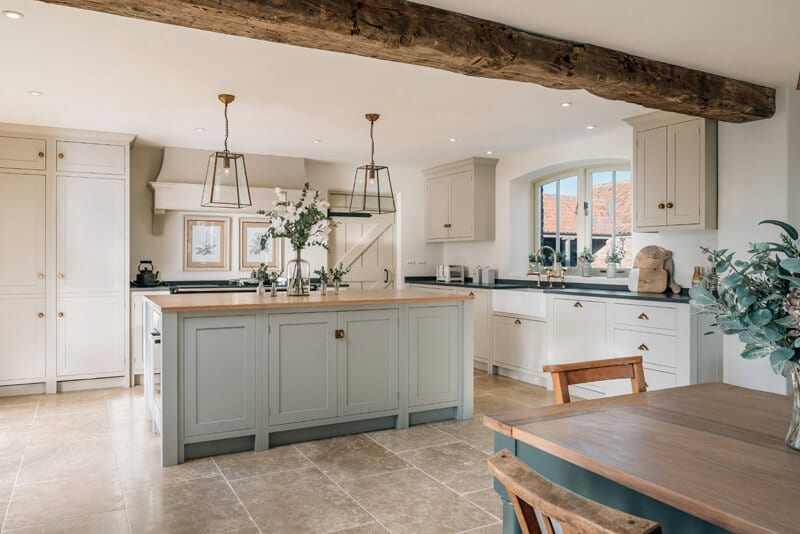
Stone tiles such as marble, granite, slate, and travertine are some of the most elegant kitchen flooring options available. They provide an upscale, natural aesthetic that enhances the overall design of a kitchen while offering impressive durability. Each stone tile has a unique appearance, making it a perfect choice for homeowners who appreciate distinctive patterns and high-end materials.
Pros:
- Luxurious Look – Elevates any kitchen space with its sophisticated and timeless appeal.
- Highly Durable – When properly maintained, stone flooring can last for decades.
- Unique Natural Patterns – No two tiles are alike, giving each kitchen floor a one-of-a-kind look.
- Heat Resistant – Stone is naturally resistant to heat, making it ideal for kitchens.
Cons:
- Expensive – One of the priciest kitchen flooring options due to material and installation costs.
- Requires Sealing – Natural stone is porous and requires regular sealing to prevent staining and water damage.
- Cold and Hard Surface – Can be uncomfortable to stand on for long periods and may require underfloor heating in colder climates.
- High Maintenance – Some stones, like marble and limestone, are prone to etching and staining from acidic substances.
Best For:
- Luxury kitchen designs that demand premium materials.
- Homeowners who want aesthetic appeal and durability in one.
- Those who don’t mind regular maintenance and sealing for a stunning natural look.
7. Cork Flooring – An Eco-Friendly and Comfortable Choice
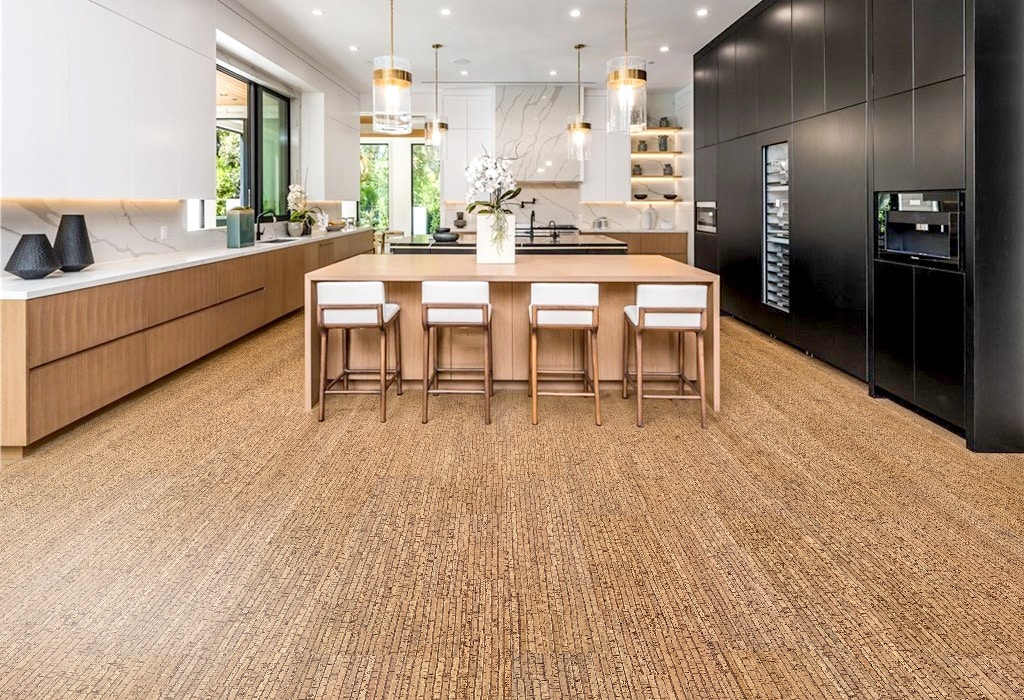
Cork flooring is an innovative and sustainable alternative for those looking for kitchen flooring ideas that are both comfortable and environmentally friendly. Made from the bark of cork oak trees, this flooring option is soft, resilient, and renewable, making it an excellent choice for homeowners prioritizing eco-conscious living.
Pros:
- Soft Underfoot – Offers excellent cushioning, reducing fatigue for those who spend long hours cooking.
- Eco-Friendly – A renewable resource that is biodegradable and sustainable.
- Resistant to Mold and Mildew – Naturally repels moisture, making it suitable for busy kitchens.
- Warm and Quiet – Provides natural insulation, keeping the kitchen warm and reducing noise.
Cons:
- Can Be Scratched Easily – Not as durable as ceramic tile or stone; prone to dents and scratches, especially in homes with pets.
- Requires Sealing – Although cork is moisture-resistant, it still needs regular sealing to protect against spills.
- Limited Design Options – Less variety compared to kitchen floor tiles or luxury vinyl flooring.
Best For:
- Eco-conscious homeowners looking for sustainable kitchen flooring options.
- People who spend a lot of time standing in the kitchen.
- Homes needing quiet, soft, and warm flooring.
8. Bamboo Flooring – A Stylish and Sustainable Alternative
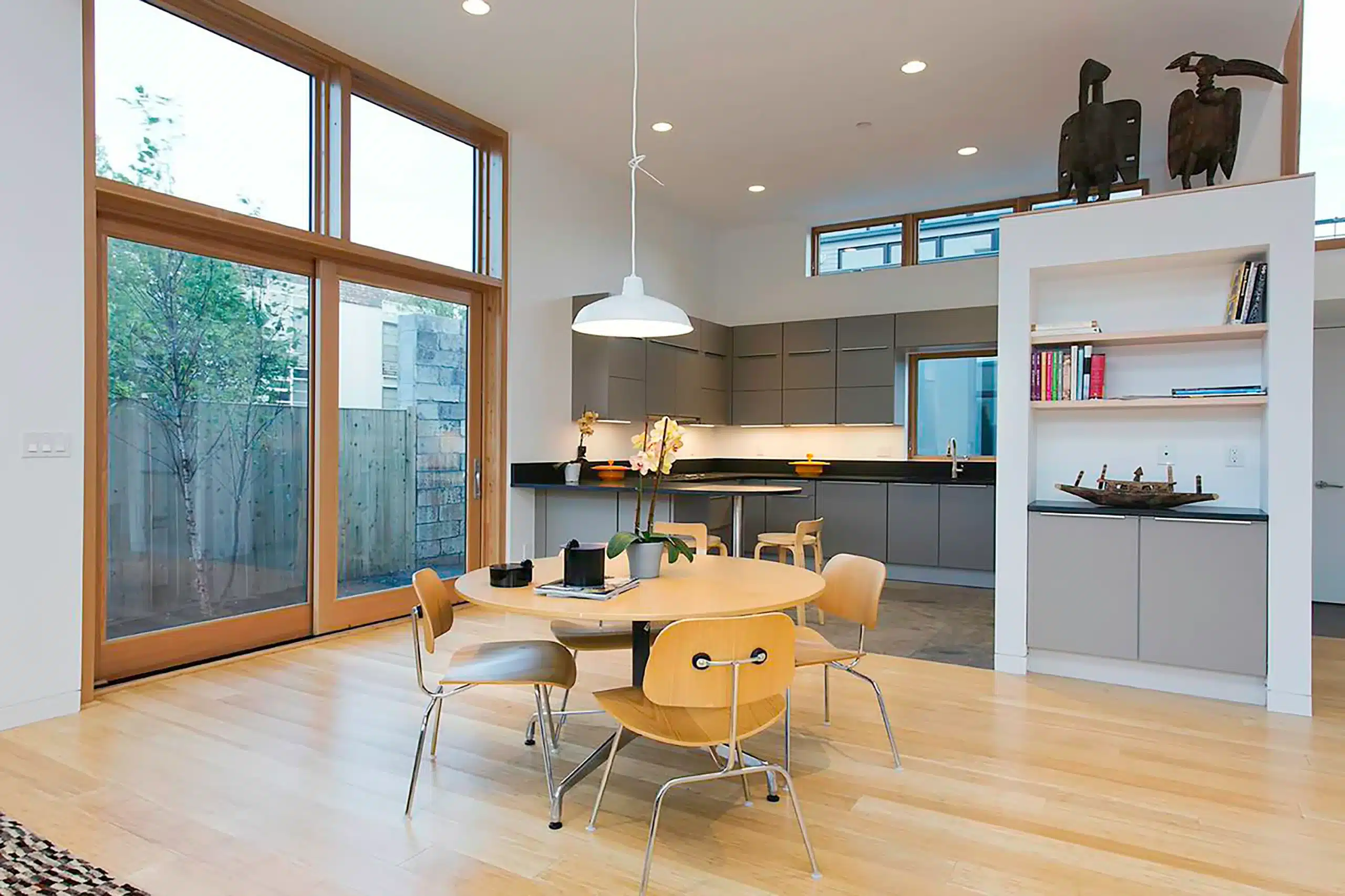
Bamboo flooring is becoming an increasingly popular kitchen flooring option due to its sustainability and durability. Made from fast-growing bamboo plants, this natural material provides a hardwood-like appearance but with added benefits such as water resistance and eco-friendliness.
Pros:
- Eco-Friendly – A renewable resource that is harvested in a sustainable manner.
- Durable and Strong – Strand-woven bamboo is harder than many hardwoods, making it a long-lasting flooring choice.
- Water-Resistant – More resistant to moisture and spills than traditional hardwood flooring.
- Aesthetic Appeal – Offers a modern, sleek look while maintaining the warmth of wood.
Cons:
- Can Scratch Easily – Susceptible to scratches from furniture, pet claws, and high-traffic areas.
- Limited Color Choices – While bamboo flooring is available in various shades, the selection is not as vast as hardwood or laminate.
- Requires Maintenance – Needs regular sealing and protection to maintain its moisture-resistant properties.
Best For:
- Sustainable home designs prioritizing eco-friendly materials.
- Homeowners looking for a moisture-resistant alternative to hardwood.
- Modern kitchens that require a durable, natural flooring solution.
9. Kitchen Floor Mats – Added Comfort and Safety
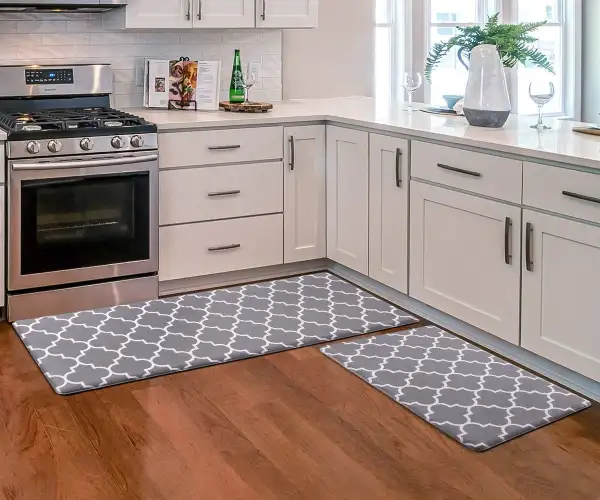
While kitchen floor mats aren’t a complete kitchen flooring option, they offer additional protection and comfort in high-traffic areas. Placing anti-fatigue mats in areas where you stand the most, such as near the sink or stove, can significantly reduce discomfort.
Pros:
- Anti-Fatigue Support – Reduces foot, knee, and back strain, making standing for long periods more comfortable.
- Protects Floors – Prevents scratches, stains, and wear in heavily used areas.
- Slip-Resistant – Enhances safety by providing extra traction, especially in wet areas.
Cons:
- Not a Complete Flooring Solution – Functions as an accessory rather than a permanent flooring option.
- Can Collect Dirt and Stains – Needs frequent cleaning to maintain hygiene and appearance.
Best For:
- Chefs and home cooks who stand for long periods.
- Homeowners who want to protect their kitchen flooring from damage.
- Kitchens where safety and slip-resistance are priorities.
Choosing the Right Kitchen Flooring
When selecting the best flooring for kitchen spaces, it’s essential to consider durability, maintenance, comfort, and budget. Here’s a quick comparison:
| Flooring Type | Durability | Water Resistance | Comfort | Cost |
|---|---|---|---|---|
| Porcelain/Ceramic Tile | High | Excellent | Low | $$ |
| Vinyl Flooring | Medium | Excellent | High | $ |
| Solid Hardwood | High | Low | Medium | $$$ |
| Engineered Hardwood | High | Medium | Medium | $$ |
| Laminate Flooring | Medium | Low-Medium | Medium | $ |
If you prioritize durability and moisture resistance, porcelain tiles or vinyl floors are your best bet. For a classic, warm aesthetic, solid hardwood or engineered hardwood would be ideal. Those on a budget might find laminate or vinyl kitchen flooring to be the best choice.
No matter which kitchen flooring option you choose, make sure it aligns with your lifestyle, design preferences, and maintenance expectations for a long-lasting, stylish kitchen floor.
Source Links:
Home Depot – Kitchen Flooring Options
https://www.homedepot.com/b/Flooring/Kitchen/N-5yc1vZaq7rLowe’s – Best Flooring for Kitchens
https://www.lowes.com/n/ideas-inspiration/6-ideas-for-kitchen-floorsThe Spruce – Durable Kitchen Flooring Options
https://www.thespruce.com/durable-kitchen-flooring-options-1315000Tileshop – Kitchen Floor Tile Ideas
https://www.tileshop.com/inspiration/tile-ideas/kitchen-floorsAmerica’s Floor Source – Best Kitchen Flooring Options
https://www.americasfloorsource.com/a/blog/what-are-the-best-kitchen-flooring-optionsSlaughterbeck Floors – Choosing the Best Kitchen Flooring
https://www.slaughterbeckfloors.com/floorology/best-flooring-for-kitchens


